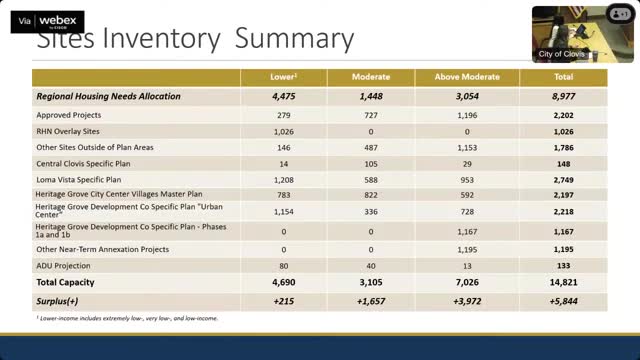City plans bold housing reforms to tackle affordability crisis
November 05, 2024 | Clovis, Fresno County, California
This article was created by AI summarizing key points discussed. AI makes mistakes, so for full details and context, please refer to the video of the full meeting. Please report any errors so we can fix them. Report an error »

In a recent government meeting, officials discussed the Regional Housing Needs Assessment (RHNA) and its implications for housing allocation across jurisdictions. The RHNA aims to achieve parity in lower-income housing distribution by adjusting allocations based on current income levels in different areas. Jurisdictions with a higher concentration of lower-income households typically receive a smaller percentage of new lower-income housing units.
The meeting highlighted several key programs within the city's housing element aimed at addressing housing challenges. Notably, Program 8 focuses on updating the development code to eliminate barriers to multifamily housing, including revising parking standards and increasing density in residential zones. Other significant initiatives include the Local Housing Trust Fund, which supports financial commitments to affordable housing, and a new ordinance requiring residential developments to allocate 5-10% of units for lower-income households.
Additionally, the city is committed to preserving existing affordable housing through programs that enforce rent stabilization in mobile home parks and provide rehabilitation loans for low-income homeowners. Efforts to affirmatively further fair housing were also discussed, including initiatives to connect extremely low-income residents with necessary resources and distribute fair housing information in multiple languages.
The review process for the housing element has been extensive, with drafts submitted to the state for compliance checks. Following public reviews and revisions, the city received feedback from the state focusing on implementation programs, fair housing assessments, and site inventory assumptions. The city is now poised to adopt the revised housing element, which, once approved, will be deemed compliant with state law.
Officials clarified that the current housing element primarily addresses new units and does not account for existing affordable housing options, such as Section 8 vouchers, which may not be reflected in the overall housing count. This distinction underscores the ongoing challenges in accurately assessing the availability of affordable housing within the community.
The meeting highlighted several key programs within the city's housing element aimed at addressing housing challenges. Notably, Program 8 focuses on updating the development code to eliminate barriers to multifamily housing, including revising parking standards and increasing density in residential zones. Other significant initiatives include the Local Housing Trust Fund, which supports financial commitments to affordable housing, and a new ordinance requiring residential developments to allocate 5-10% of units for lower-income households.
Additionally, the city is committed to preserving existing affordable housing through programs that enforce rent stabilization in mobile home parks and provide rehabilitation loans for low-income homeowners. Efforts to affirmatively further fair housing were also discussed, including initiatives to connect extremely low-income residents with necessary resources and distribute fair housing information in multiple languages.
The review process for the housing element has been extensive, with drafts submitted to the state for compliance checks. Following public reviews and revisions, the city received feedback from the state focusing on implementation programs, fair housing assessments, and site inventory assumptions. The city is now poised to adopt the revised housing element, which, once approved, will be deemed compliant with state law.
Officials clarified that the current housing element primarily addresses new units and does not account for existing affordable housing options, such as Section 8 vouchers, which may not be reflected in the overall housing count. This distinction underscores the ongoing challenges in accurately assessing the availability of affordable housing within the community.
View full meeting
This article is based on a recent meeting—watch the full video and explore the complete transcript for deeper insights into the discussion.
View full meeting
